
Полная версия
Small Talk: B1+

Deborah Capras
Small Talk

Collins
HarperCollins Publishers,
77–85 Fulham Palace Road,
Hammersmith,
London W6 8JB
www.harpercollins.co.uk
First edition 2014
© HarperCollins Publishers 2014
Collins® is a registered trademark of HarperCollins Publishers Limited
A catalogue record for this book is available from the British Library
Cover image © iStock.com/skynesher
All rights reserved under International and Pan-American Copyright Conventions. By payment of the required fees, you have been granted the non-exclusive, non-transferable right to access and read the text of this e-book on screen. No part of this text may be reproduced, transmitted, downloaded, decompiled, reverse engineered, or stored in or introduced into any information storage and retrieval system, in any form or by any means, whether electronic or mechanical, now known or hereinafter invented, without the express written permission of HarperCollins.
HarperCollins does not warrant that www.collinselt.com or any other website mentioned in this title will be provided uninterrupted, that any website will be error free, that defects will be corrected, or that the website or the server that makes it available are free of viruses or bugs. For full terms and conditions please refer to the site terms provided on the website.
Every effort has been made to contact the holders of copyright material, but if any have been inadvertently overlooked, the Publisher will be pleased to make the necessary arrangements at the first opportunity.
HarperCollinsPublishers has made every reasonable effort to ensure that any picture content and written content in this ebook has been included or removed in accordance with the contractual and technological constraints in operation at the time of publication.
Source ISBN: 9780007546237
Ebook Edition © JUNE 2014 ISBN: 9780007574759
Version: 2014-08-19
Contents Map
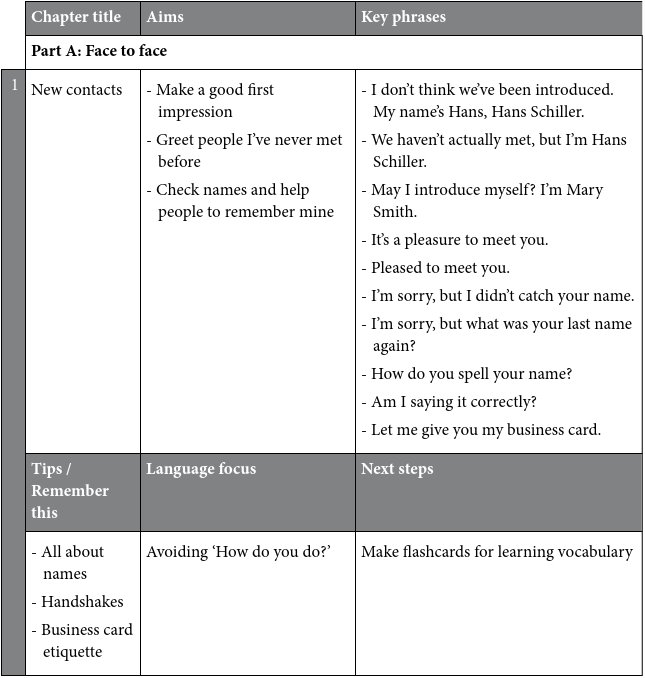
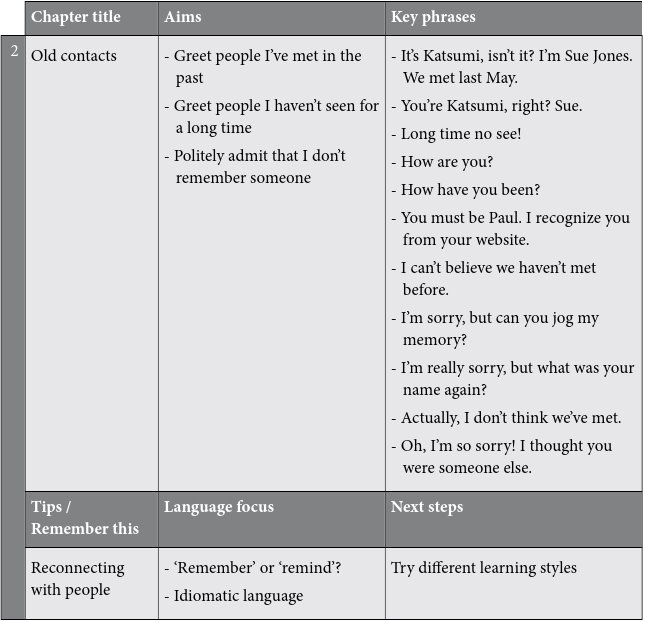
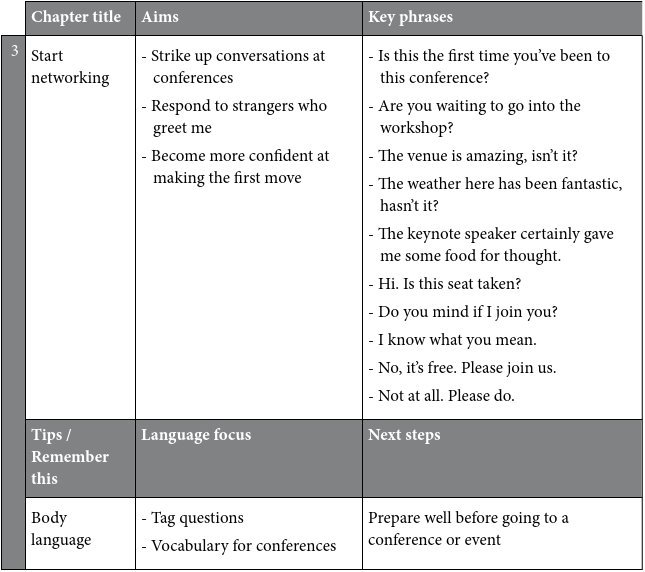
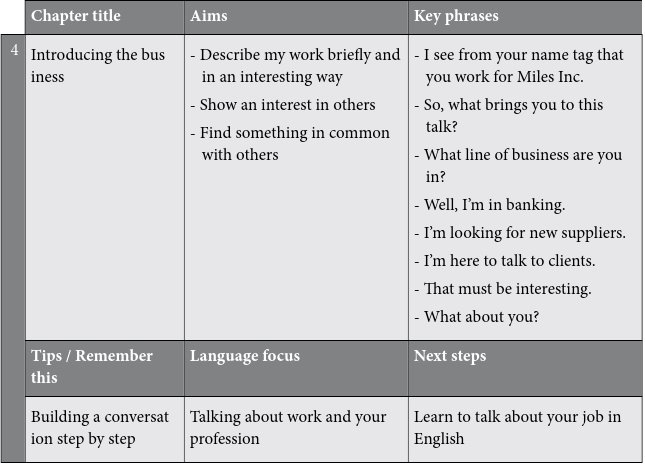
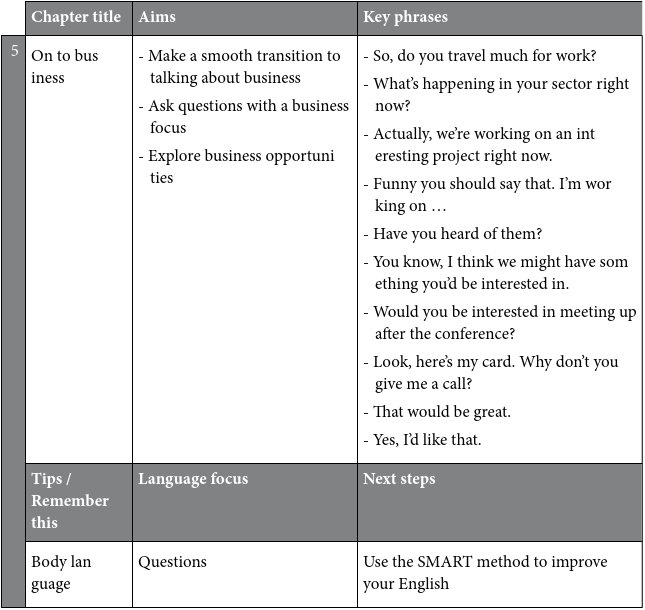
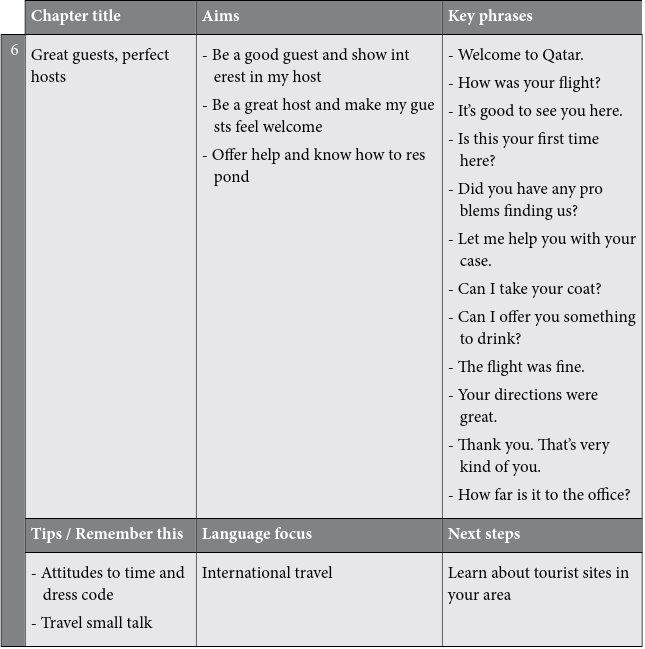
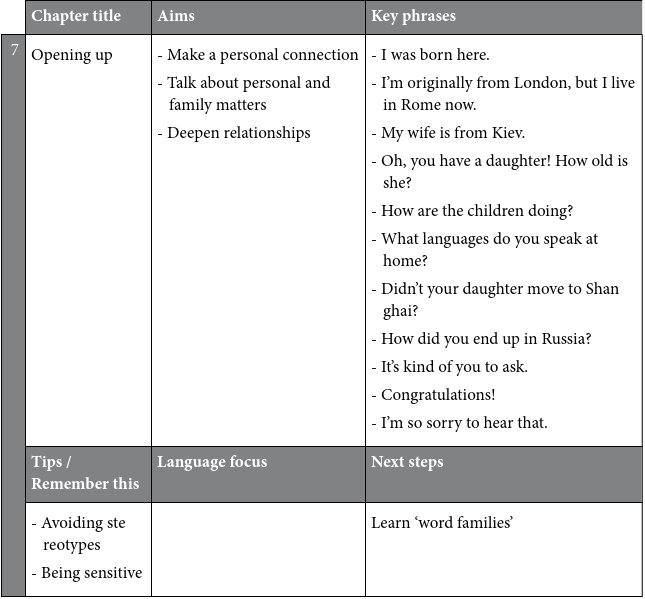
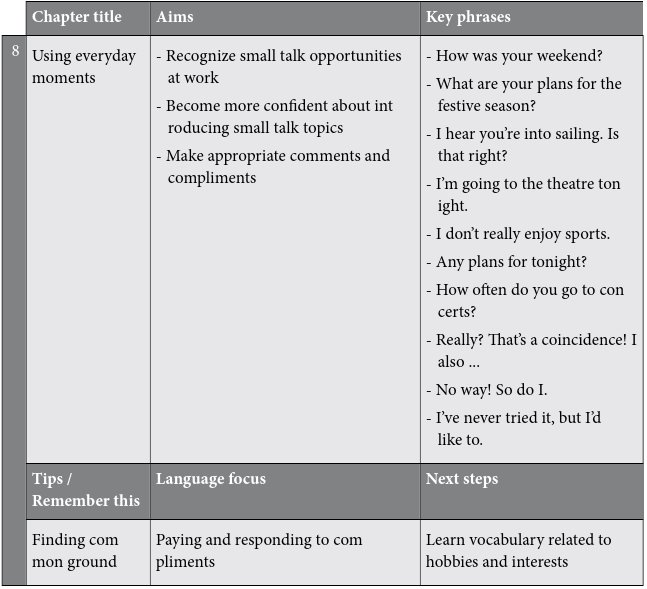
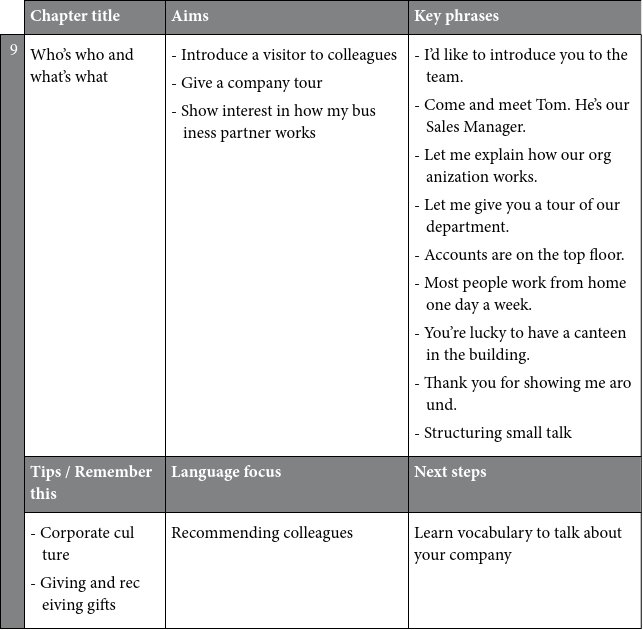
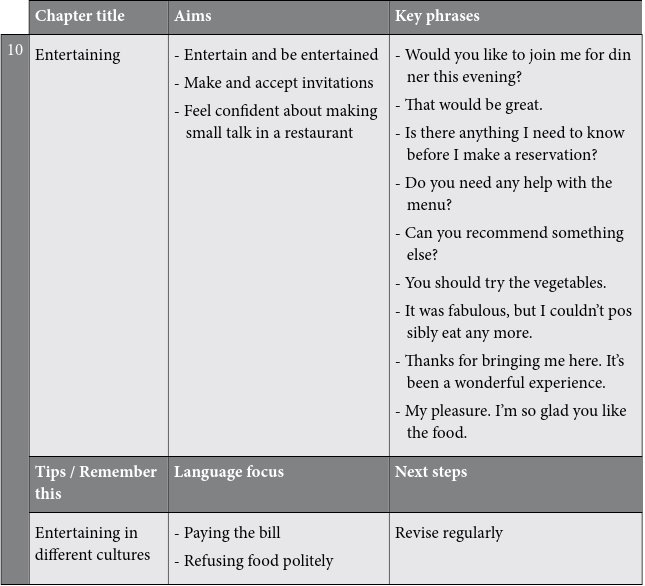
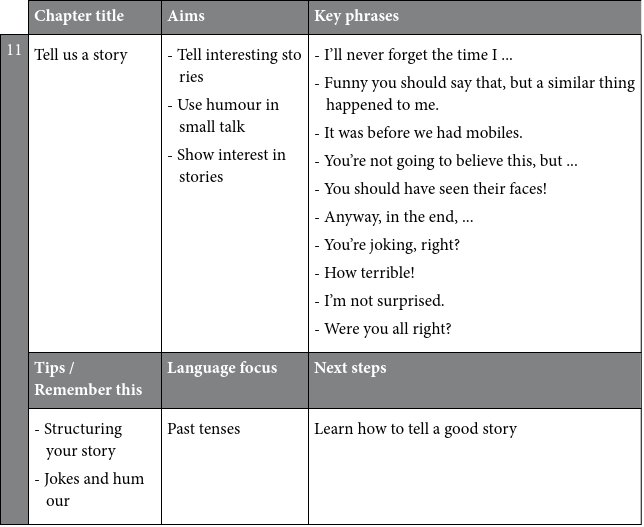
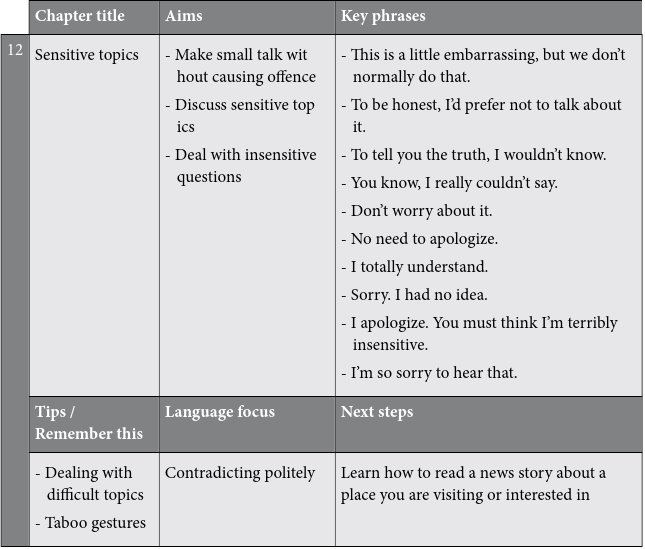
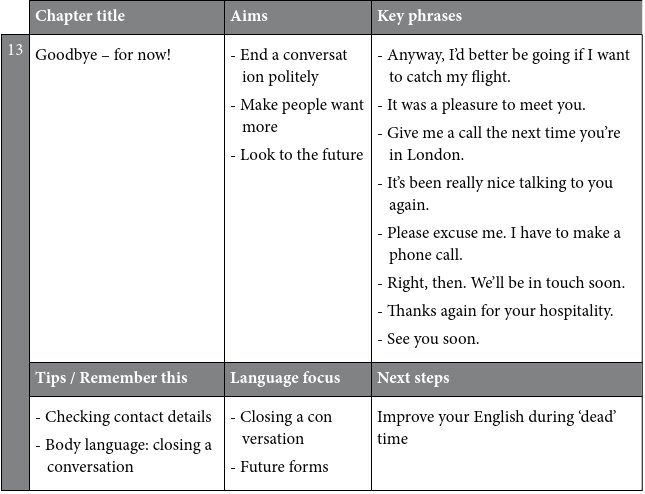
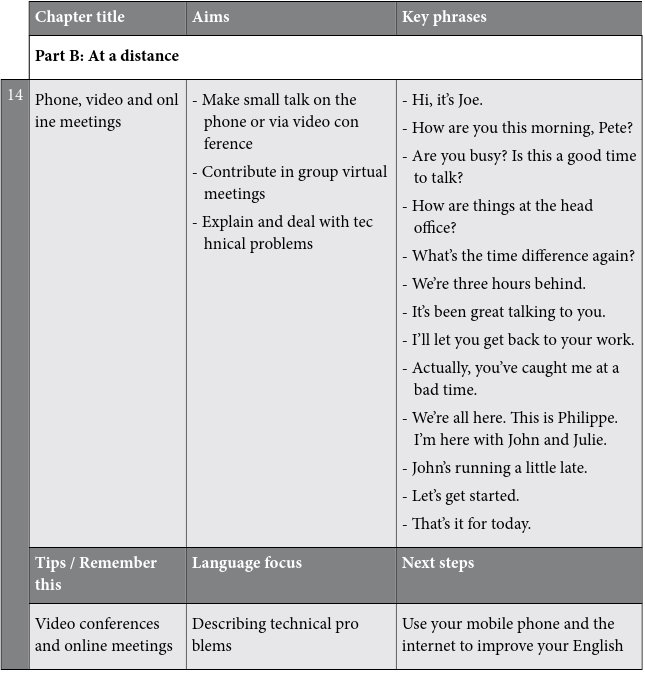
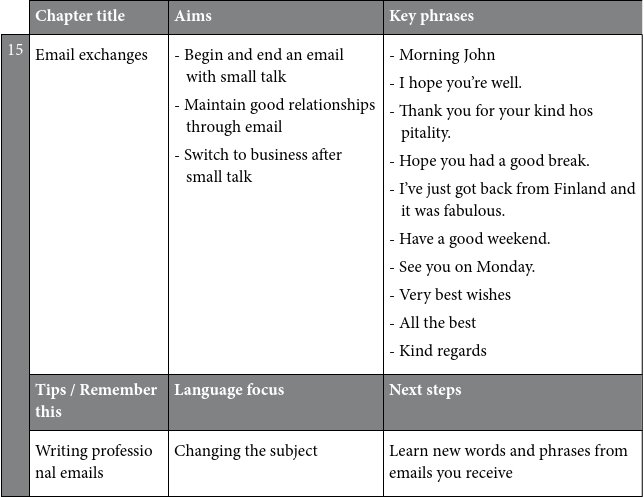
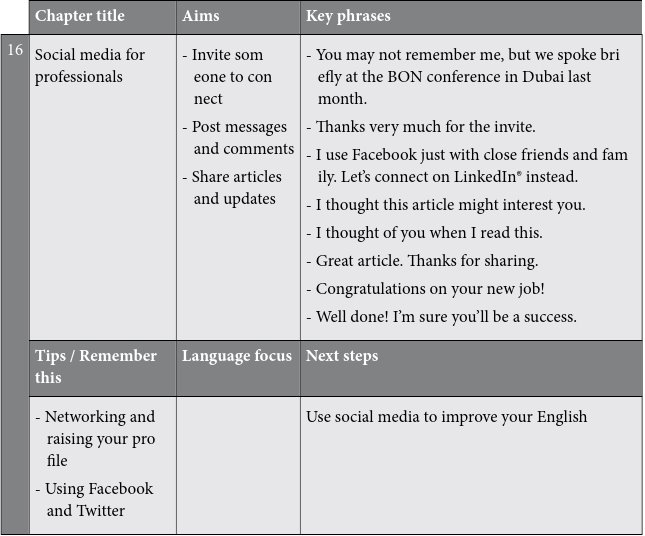
Introduction
Small talk is not small
We all prefer to do business with people we trust. To build trust with your business partners, you need to have good working relationships and you can create the basis for such relationships if you can connect with people on a personal level. Small talk can help you to make this connection.
Why make small talk?
● To create a bond: By opening up about your interests, you can create a more personal bond with someone and therefore a better relationship.
● To create a network: You can find the best business partners in business situations and at social events. If you can engage with strangers using small talk, you can create a network of people you can call on for their expertise. And they, in turn, will want to add you to their networks.
● To create a positive atmosphere: You can use small talk to make yourself and others feel at ease.
What factors influence small talk?
Place
The way you make small talk with a stranger at a conference is different from the way you talk to someone who is visiting your office or someone at an evening event. If you are welcoming a visitor to your office, you need to make them feel at ease. At a conference, you are on neutral ground and can use small talk simply to make contacts. At an evening event, you are also on neutral ground and the situation is more likely to be relaxed. Therefore, topics may be more personal.
Personality
According to the Myers-Briggs Type Indicator®, a popular tool that identifies people as belonging to distinctive personality types, some people are more extroverted and others are more introverted. Extroverts enjoy social events and group conversations with lots of different people. They become energized in social situations, often moving quickly from one topic of conversation to another. Introverts, on the other hand, prefer one-on-one conversations. They will often talk about fewer topics, but in more detail. They may be better at keeping in touch at a distance, via email for example. They aren’t necessarily bad at small talk, but they may find it harder and more tiring; they may be better listeners. So does this mean that introverts and extroverts can’t talk to each other? Not at all. If you are an extrovert, give the introverts time to join in. If you are introverted, make the most of your one-on-one interactions. By the way, no one type is seen as good or bad – they are just different.
Relationship
To some extent, the kind of small talk you make depends on the status of the person you are talking to. It is generally more relaxed between people who have a similar status than, for example, between a receptionist and a CEO. Small talk could still be important, but it may be more limited.
The longer you know someone, the friendlier and more informal small talk can be. Less formal language helps to build personal relationships. If you are too formal, you may create a distance that is hard to bridge.
Gender
For many years Deborah Tannen, a sociolinguist and author of You Just Don’t Understand: Women and Men in Conversation, has been studying how men and women communicate and interact. She describes the type of talk that men make as ‘report-talk’. By this, she means that they like to exchange information about impersonal topics. Women, however, generally prefer ‘rapport-talk’, which focuses on personal relationships and is more intimate. She also notes that men tend to talk more in public than women.
Culture
What are your cultural values? Do you know what values are important to your business partner? The closer your values, the more you will have in common and the easier it is to make small talk. Culture is influenced by many different factors, including language, religion, societal norms and traditions. Knowing your business partner’s cultural values may help you to decide which topics you can discuss together.
Fons Trompenaars, a leading expert on intercultural communication and author of Riding the Waves of Culture: Understanding Cultural Diversity in Business, has studied the extent to which our cultural values affect the way we interact with people and how we do business. He uses the terms ‘specific’ and ‘diffuse’ to describe how people from different cultures view their professional and private lives.
In ‘specific’ cultures such as the Netherlands and Switzerland, people like to keep their private lives private. They believe that relationships are important, but not necessary to do business. In ‘diffuse’ cultures such as China, India, Russia and Spain, private and professional lives are closely linked. People from these cultures believe that a good personal relationship is vital to doing business and they often spend time socializing outside of work.
Be prepared to make small talk
We make small talk based on what is happening around us, what is important to us, our experiences and our feelings. Small talk is often spontaneous and random, so it is difficult to predict what people will talk about. You need to have a passive understanding of many expressions to follow many small talk exchanges, but you can take part using a much smaller set of key phrases.
This book will go a long way towards helping you to learn key phrases for a variety of situations. It also presents the language that you are likely to hear, especially when talking to native speakers of English.
How to use this book
The language level of this book is B1–B2 on the Common European Framework of Reference, equivalent to intermediate–upper-intermediate level.
This book can be used as a self-study guide or as part of a course. Work through each chapter in order or refer to a specific chapter before you go to a conference, to a meeting or to the office of a business partner and focus on the key phrases you will need. Use the book as a resource when you know you will have the opportunity to meet people and to make small talk in English.
Overview
Part A: Face to face
As most small talk interactions are face to face, most chapters focus on this type of communication.
Part B: At a distance
There are long periods of time between face-to-face meetings when you need to communicate and build on your relationship via email or on the phone. Nowadays, with a lot of business conducted via email, you may have business partners that you never meet face to face. Nevertheless, it is still important to make use of small talk opportunities.
Part C: Communication strategies
This part has tips and suggestions on how to improve your general communication strategies. There is also a special focus on body language and how to spell out names and email addresses.
Answer key
There is a comprehensive answer key at the back of the book.
Audio
All audio for this book is available free online. Go to www.collinselt.com/businessresources to listen to it.
On the website you will notice that we have two different types of audio. First, all key phrases and scenarios have been recorded in a studio as a model for you to follow. You can listen to this audio and repeat the phrases to practise your pronunciation and intonation. We have also recorded real-life audio. By this we mean real people using small talk on location (i.e. not in the studio). In this audio, you will hear people using ‘um’ and ‘uh’ when they are thinking about what they want to say. You will also hear different accents. Listening to this real-life audio is good practice as it increases your awareness and sensitivity to different speakers of English. There are full transcripts of the real-life audio online so you can read along while you are listening.
Chapter structure
My goals
There are three clear goals for each chapter.
Quiz
Before you can start to improve your small talk skills, you need to think about what you can do and where you need help. Answer the questions in the self-awareness quiz honestly.
Study focus
Each chapter focuses on one area of small talk. This section sets the scene and tells you what to look out for.
Key phrases
The key phrases are a vital section of each chapter. These are common phrases that you should learn because they will give you the confidence to deal with many kinds of small talk situations. The key phrases are highlighted so that they are easy to find. For example, before you go to a networking event, you could look up the key phrases you would need to make small talk there.
To start with, you may only want to learn to use one key phrase for each situation and simply recognize the others when you hear them. As you gain confidence, you can learn to use more key phrases. You can listen to all the key phrases in Part A online.
Scenarios
This section has dialogues and written communications that show you how the key phrases are used in context. You can listen to all the Part A dialogues online.
Over to you
You need to practise to make progress. This section has exercises that give you the chance to practise the new language and personalize what you learn.
Language focus
Many of the chapters have a section that explains a specific language point. These sections focus on the kind of language you might hear and will need to understand, and they also look at aspects of grammar.
Remember this!
Here you will find additional information about the topic of the chapter, such as details about culture, traditions and common business practices.
Tips
Here you will find useful tips on what you can do to improve your small talk skills.
Next steps
This section has useful advice on how to improve your study skills.
Finally …
Make sure you try out the language you have learnt in real business situations and don’t worry too much about making mistakes. Generally, people don’t pay a lot of attention to language errors, but they won’t forget someone who is showing an interest in them and is interesting to talk to. That is what small talk is really all about.
Part A: Face to face
1 New Contacts

My goals
• Make a good first impression
• Greet people I’ve never met before
• Check names and help people to remember mine
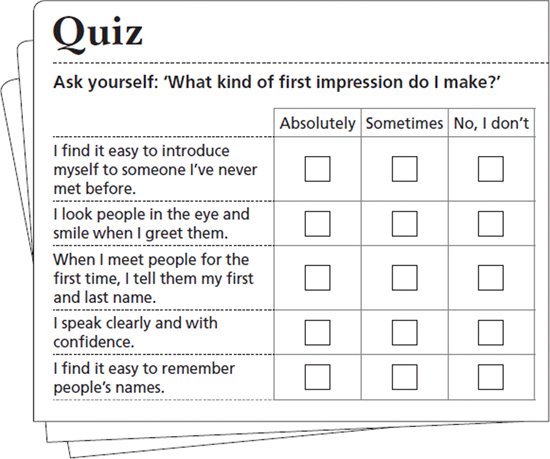
At conferences, networking events and even in the office – wherever you do business – you will meet new people. How do you make a good first impression? A warm, friendly greeting will help you. Using small talk to start a conversation will help too. Try to make sure that people remember you and try to remember them too. You might not hear their name properly the first time, and in this chapter you will learn how to ask people to repeat their name.
Key phrases
Making the first move
I don’t think we’ve been introduced. My name’s Hans, Hans Schiller.
Hi, I’m Mary, Mary Smith.
We haven’t actually met, but I’m Hans Schiller.
May I introduce myself? I’m Mary Smith.
I don’t think we’ve met. I’m Mary Smith.
Giving the right response
It’s a pleasure to meet you.
Pleased to meet you.
(It’s) good/great/nice to meet you.
(It’s) good/great/nice to meet you too.
Checking names
I’m sorry, but I didn’t catch your name.
I’m sorry, but what was your last name again?
How do you spell your name?
‘Athanasis’. Am I saying it correctly?
Helping people to remember your name
Please, call me John.
Let me give you my (business) card.
Here’s my (business) card.

Scenarios
Rena: Hi, I don’t think we’ve met. I’m Rena Chioti.
Antonio: Nice to meet you, Ms Chioti. Am I saying it correctly?
Rena: Yes, but please, call me Rena.
Antonio: Rena. I’m Antonio, Antonio Messina.
Rena: Good to meet you too, Antonio. How do you spell your name? Is it with double ‘s’?
Antonio: Yes, like the city in Sicily. My family’s from there.
Rob: We haven’t actually met, but I’m Rob Williams.
Markus: It’s a pleasure to meet you. I’m Professor Kern, Markus Kern.
Rob: It’s good to meet you too.
Markus: I’m sorry, but I didn’t catch your last name.
Rob: It’s Williams, as in Robbie Williams. You know, the singer. Let me give you my business card.
Markus: Thank you. And here’s mine.
Jules: Hello. I don’t think we’ve been introduced. My name’s Jules, Jules Chirac.
Sergei: Oh, I’m sorry, Jules! Sandra, this is Jules Chirac, our designer in our French office. Jules, this is Sandra Harper. She’s with RTV.
Sandra: Nice to meet you, Jules. I’ve seen your work. It’s impressive.
Jules: Thank you. That’s great to hear. It’s nice to meet you too.

Over to you
1 Match the sentence beginnings with the sentence endings.

2 John is talking to Sayuri when Ria joins them. Put the dialogue in the correct order.
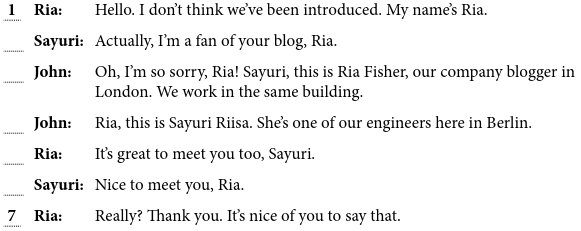
3 Check your understanding. Answer the questions about the dialogue in exercise 2.

4 Complete the sentences with the correct form of the verbs in the box.

1. I don’t think we................................
2. ‘Sahinda’. Am I............................... it correctly?
3. May I............................... myself?
4. Let me............................... you my card.
5. I’m sorry, but I............................... your last name.
6. Could you............................... your last name for me?
5 Complete the dialogue.
You: (1) (Say that you don’t know each other and give your name.)
..............................................................................................
..............................................................................................
Paul: It’s a pleasure to meet you. I’m Paul Mathews.
You: (2) (Respond to the greeting and say that you didn’t hear Paul’s last name.)
..............................................................................................
..............................................................................................
Paul: It’s Mathews. But please, call me Paul. I’m sorry, but how do you spell your name?
You: (3) (Spell your name and offer your business card. If possible, say something about your name to help Paul to remember it.)
..............................................................................................
..............................................................................................
6 Can you say the letters of your name in English?
Language focus: How do you do?
Avoid using the old-fashioned phrase How do you do? It can sound solemn and too formal. If someone does use it to greet you, the fixed response is How do you do?
Remember this! Handshakes● The purpose of a handshake is to show respect and to perform a greeting ritual.
● Not everyone shakes hands, but in international business situations and contexts, a handshake when greeting someone is common.
● People from different cultures may expect different greetings, especially in their own countries. In Japan you may be greeted with a bow. In some countries, in particular in the Middle East and India, it is best not to offer your hand in greeting, especially to women.
● In some countries people may shake hands more often than in others. In Germany, for example, people often shake hands when they meet for the first time, when they leave and then every time they meet again, even if it is the next day. In the UK, however, people may only shake hands when they meet for the first time. Observe how people behave and do the same.
● Asian people usually have a gentle handshake. Americans generally expect handshakes to be firmer.
● If you are unsure what to do, wait for the other person to initiate the handshake.
● Don’t hold on to a person’s hand for too long. It can make them feel uncomfortable.
● Don’t use both your hands to shake someone’s hand. This may make the other person feel that you think you are more important than them.
● Don’t shake hands so roughly or firmly that you could hurt someone – and don’t shake hands very weakly either. What people will remember positively is a short, fairly strong handshake.
Tips: All about names● For a warm and friendly greeting, tell people your first name as well as your last.
● If someone says their last name first, they probably expect you to use it (e.g. ‘Mr Smith’).
● If someone gives you their title, they expect you to use that too (e.g. ‘Dr Chen’).
● Someone with a more senior position in an organization might prefer to use last names.
● Repeat the person’s name as soon as you can.
● If you didn’t catch someone’s name, ask for it again.
● Say something about your name to help people to remember it.
Remember this! Business card etiquette● Exchanging business cards should be part of the conversation. Generally, people don’t hand out cards until they have been introduced.
● Take enough cards with you to meetings and events. It is unprofessional to say you don’t have any (more) with you.
● Keep your cards in a case – they stay cleaner. And know where they are. People who can’t find their cards look disorganized.
● Give and receive cards with your right hand. In Asia people often like to give and receive cards using both hands. By showing respect to the cards, you show respect to each other.
● Make sure that your card is the right way round and the right way up when you hand it to the person you are talking to.
● You can add a note to your own card, but it is best not to write on someone else’s, especially in Japan. People there may find this impolite. If you need to write something on it to help you to remember the person, do so later.
● Try to make a positive comment about some aspect of a person’s card, such as the company logo or the colour.



